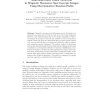Free Online Productivity Tools
i2Speak
i2Symbol
i2OCR
iTex2Img
iWeb2Print
iWeb2Shot
i2Type
iPdf2Split
iPdf2Merge
i2Bopomofo
i2Arabic
i2Style
i2Image
i2PDF
iLatex2Rtf
Sci2ools
94
Voted
DAGM
2007
Springer
2007
Springer
Semi-supervised Tumor Detection in Magnetic Resonance Spectroscopic Images Using Discriminative Random Fields
Magnetic resonance spectral images provide information on metabolic processes and can thus be used for in vivo tumor diagnosis. However, each single spectrum has to be checked manually for tumorous changes by an expert, which is only possible for very few spectra in clinical routine. We propose a semi-supervised procedure which requires only very few labeled spectra as input and can hence adapt to patient and acquisition specific variations. The method employs a discriminative random field with highly flexible single-side and parameter-free pair potentials to model spatial correlation of spectra. Classification is performed according to the label set that minimizes the energy of this random field. An iterative procedure alternates a parameter update of the random field using a kernel density estimation with a classification by means of the GraphCut algorithm. The method is compared to a single spectrum approach on simulated and clinical data.
| Added | 07 Jun 2010 |
| Updated | 07 Jun 2010 |
| Type | Conference |
| Year | 2007 |
| Where | DAGM |
| Authors | L. Görlitz, Bjoern H. Menze, M.-A. Weber, B. Michael Kelm, Fred A. Hamprecht |
Comments (0)

